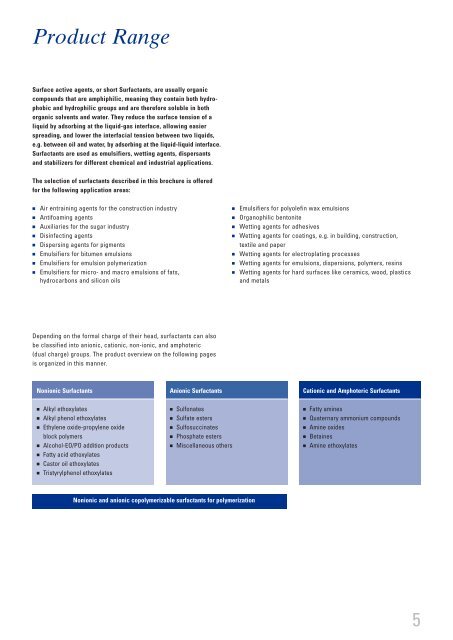Process aids for the Chemical Industry. - Industrial Lubricants ...
Process aids for the Chemical Industry. - Industrial Lubricants ...
Process aids for the Chemical Industry. - Industrial Lubricants ...
You also want an ePaper? Increase the reach of your titles
YUMPU automatically turns print PDFs into web optimized ePapers that Google loves.
Product Range<br />
Surface active agents, or short Surfactants, are usually organic<br />
com pounds that are amphiphilic, meaning <strong>the</strong>y contain both hydrophobic<br />
and hydrophilic groups and are <strong>the</strong>re<strong>for</strong>e soluble in both<br />
organic solvents and water. They reduce <strong>the</strong> surface tension of a<br />
liquid by adsorbing at <strong>the</strong> liquid-gas interface, allowing easier<br />
spreading, and lower <strong>the</strong> interfacial tension between two liquids,<br />
e.g. between oil and water, by adsorbing at <strong>the</strong> liquid-liquid interface.<br />
Surfactants are used as emulsifiers, wetting agents, dispersants<br />
and stabilizers <strong>for</strong> different chemical and industrial applications.<br />
The selection of surfactants described in this brochure is offered<br />
<strong>for</strong> <strong>the</strong> following application areas:<br />
■ Air entraining agents <strong>for</strong> <strong>the</strong> construction industry<br />
■ Antifoaming agents<br />
■ Auxiliaries <strong>for</strong> <strong>the</strong> sugar industry<br />
■ Disinfecting agents<br />
■ Dispersing agents <strong>for</strong> pigments<br />
■ Emulsifiers <strong>for</strong> bitumen emulsions<br />
■ Emulsifiers <strong>for</strong> emulsion polymerization<br />
■ Emulsifiers <strong>for</strong> micro- and macro emulsions of fats,<br />
hydrocarbons and silicon oils<br />
Depending on <strong>the</strong> <strong>for</strong>mal charge of <strong>the</strong>ir head, surfactants can also<br />
be classified into anionic, cationic, non-ionic, and amphoteric<br />
(dual charge) groups. The product overview on <strong>the</strong> following pages<br />
is organized in this manner.<br />
Nonionic Surfactants<br />
■ Alkyl ethoxylates<br />
■ Alkyl phenol ethoxylates<br />
■ Ethylene oxide-propylene oxide<br />
block polymers<br />
■ Alcohol-EO/PO addition products<br />
■ Fatty acid ethoxylates<br />
■ Castor oil ethoxylates<br />
■ Tristyrylphenol ethoxylates<br />
Anionic Surfactants<br />
■ Sulfonates<br />
■ Sulfate esters<br />
■ Sulfosuccinates<br />
■ Phosphate esters<br />
■ Miscellaneous o<strong>the</strong>rs<br />
Nonionic and anionic copolymerizable surfactants <strong>for</strong> polymerization<br />
■ Emulsifiers <strong>for</strong> polyolefin wax emulsions<br />
■ Organophilic bentonite<br />
■ Wetting agents <strong>for</strong> adhesives<br />
■ Wetting agents <strong>for</strong> coatings, e.g. in building, construction,<br />
textile and paper<br />
■ Wetting agents <strong>for</strong> electroplating processes<br />
■ Wetting agents <strong>for</strong> emulsions, dispersions, polymers, resins<br />
■ Wetting agents <strong>for</strong> hard surfaces like ceramics, wood, plastics<br />
and metals<br />
Cationic and Amphoteric Surfactants<br />
■ Fatty amines<br />
■ Quaternary ammonium compounds<br />
■ Amine oxides<br />
■ Betaines<br />
■ Amine ethoxylates<br />
5


